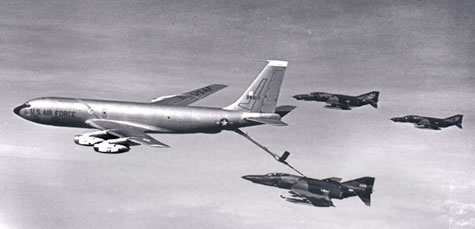Alone, Unarmed, and Unafraid
RF-4C pictures in the air and at Udorn
Passing gas up close and personal, a disaster avoided, armament for the unarmed. This slide show starts and advances automatically; or you may control it manually with the buttons and controls below.
Move
 Three RF-4s refueling over Laos. The gas station is a KC-135 (civilian: Boeing 707). Routinely, F-4s (bombers) air refueled before—and sometimes after—visiting the target area. Just as routinely, RF-4s flying out of Udorn air refueled only prior to the rare mission which included F-4 companionship--or, after a mission over (nom de guerre: Hot Dog) North Vietnam which recovered at Tan Son Nhut. (Photo credit: library of Dick Hammaker; used by permission.)
Three RF-4s refueling over Laos. The gas station is a KC-135 (civilian: Boeing 707). Routinely, F-4s (bombers) air refueled before—and sometimes after—visiting the target area. Just as routinely, RF-4s flying out of Udorn air refueled only prior to the rare mission which included F-4 companionship--or, after a mission over (nom de guerre: Hot Dog) North Vietnam which recovered at Tan Son Nhut. (Photo credit: library of Dick Hammaker; used by permission.) This single ship RF-4 is refueling with the photo cartridge doors open—a safety no-no (see: Flying United, this Web site). Risking the discharge of canisters containing sufficient white phosphorous to generate at least 110 million candlepower each in close proximity to 300,000 pounds or so (45,000+ gallons) of jet fuel was considered poor form. (Photo credit: library of Dick Hammaker; used by permission.)
This single ship RF-4 is refueling with the photo cartridge doors open—a safety no-no (see: Flying United, this Web site). Risking the discharge of canisters containing sufficient white phosphorous to generate at least 110 million candlepower each in close proximity to 300,000 pounds or so (45,000+ gallons) of jet fuel was considered poor form. (Photo credit: library of Dick Hammaker; used by permission.) Aerial refueling from a KC-97—this one flown by the Illinois National Guard—was not a Vietnam experience. This photo was probably taken over Western Europe. The photograph is included because it has historical interest and it demonstrates the versatility of the RF-4. Note the angle of attack (noses up) of the two RF-4s; the refueling speed was slow (about 250 knots indicated airspeed). Taking on a full fuel load occasionally required the RFs to extend wing flaps half down; failure to do so with a full fuel load sometimes resulted in a slight buzz (buffet)—the first indicator the wing was beginning to stall.
Aerial refueling from a KC-97—this one flown by the Illinois National Guard—was not a Vietnam experience. This photo was probably taken over Western Europe. The photograph is included because it has historical interest and it demonstrates the versatility of the RF-4. Note the angle of attack (noses up) of the two RF-4s; the refueling speed was slow (about 250 knots indicated airspeed). Taking on a full fuel load occasionally required the RFs to extend wing flaps half down; failure to do so with a full fuel load sometimes resulted in a slight buzz (buffet)—the first indicator the wing was beginning to stall. As 425 takes off on runway 12 at Udorn, the backseater turns his full attention to the photographer. The two story barracks in the background provided housing for enlisted men. Air crews (officers) were housed in hooches (see: Udorn RTAFB this Web site). (Photo credit: library of Dick Hammaker; used by permission.)
As 425 takes off on runway 12 at Udorn, the backseater turns his full attention to the photographer. The two story barracks in the background provided housing for enlisted men. Air crews (officers) were housed in hooches (see: Udorn RTAFB this Web site). (Photo credit: library of Dick Hammaker; used by permission.) An RF-4 with external fuel tanks and one (of two) AN/ALQ-87 (or et seq.) ECM (electronic countermeasures) pod. In this view the external fuel tanks are clearly visible. Typically, fuel from the centerline tank was burned first, followed by the fuel from the two external wing tanks. For missions going downtown (Hanoi, Haiphong, and all environs in-between, AKA Route Pack VI) the centerline and external wing tanks were jettisoned in flight as they went Bingo: emptied of fuel (see “The Longest Run” in Alone, Unarmed and Unafraid; see Downtown and Other Places in Harm’s Way this Web site). (Photo credit: library of Don Pickard; used by permission)
An RF-4 with external fuel tanks and one (of two) AN/ALQ-87 (or et seq.) ECM (electronic countermeasures) pod. In this view the external fuel tanks are clearly visible. Typically, fuel from the centerline tank was burned first, followed by the fuel from the two external wing tanks. For missions going downtown (Hanoi, Haiphong, and all environs in-between, AKA Route Pack VI) the centerline and external wing tanks were jettisoned in flight as they went Bingo: emptied of fuel (see “The Longest Run” in Alone, Unarmed and Unafraid; see Downtown and Other Places in Harm’s Way this Web site). (Photo credit: library of Don Pickard; used by permission) A LORAN clothesline antenna is installed just in front of the vertical stabilizer of OZ 609; the antenna is there to receive LORAN signals. In 1970 Udorn RF4s conducted LORAN accuracy tests; the accuracy was spot-on. So spot-on that ARN-92 LORAN D was retro-fitted on all Block 40 RF4s plus aircraft 69-0349 and 69-0350.
A LORAN clothesline antenna is installed just in front of the vertical stabilizer of OZ 609; the antenna is there to receive LORAN signals. In 1970 Udorn RF4s conducted LORAN accuracy tests; the accuracy was spot-on. So spot-on that ARN-92 LORAN D was retro-fitted on all Block 40 RF4s plus aircraft 69-0349 and 69-0350.

